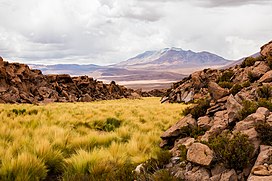Olca
| Olca | |
|---|---|
 | |
| Highest point | |
| Elevation | 5,407 m (17,740 ft) |
| Coordinates | 20°56′0″S 68°29′0″W / 20.93333°S 68.48333°W |
| Geography | |
| Location | Bolivia, Nor Lípez Province, San Pedro de Quemes Municipality, Cana Canton Chile, Antofagasta Region, El Loa Province |
| Parent range | Andes |
| Geology | |
| Mountain type | Stratovolcano |
| Last eruption | 1867 |
Olca is a stratovolcano on the border of Chile and Bolivia. It lies in the middle of a 15 km long ridge composed of several stratovolcanos. Cerro Minchincha lies to the west and Paruma to the east. It is also close to the pre-Holocene Cerro Paruma. It is andesitic and dacitic in composition, with lava flows extending several kilometres north of the peak. The only activity from the ridge during historical times was a flank eruption from 1865 to 1867. The exact source of this eruption is unclear.
Gas emissions and composition
[edit]The gasses emission is comprised by a single warm spring at the base[1] and a persistent fumarole field over at the crater's dome for at least 60 years.[2] The fumarolic field is about 0.1 km2 and the emissions measured in situ at the crater show a highly mixed magmatic system between high temperature gasses and hydrothermal fluids.
The gas composition indicates low concentration of H2, CO and acidic gasses, and high concentration of H2S and hydrocarbons.[2] The carbon/sulfur ratios are high and the isotopic values suggest the mixture between magmatic, hydrothermal, and atmospheric fluids.[2] Other techniques used to measure the amount of SO2 includes remote sensing techniques called Differential Optical Absorption Spectroscopy(DOAS) giving maximum concentration of 35 ppm.m of SO2;[3] and the most recent taken with a UV camera suggesting an average of 18.4 t d−1.[4]
Eruptive history and latest activity
[edit]Different information exists regarding the activity and activity migration of Olca. There is a study dating two flows, which suggest a formation during the Pleistocene,[5] while others suggest to be much older with the appearance of the edifices volcanic activity migrated east over time.[6] There is also evidence that glaciers were on the volcano in the late Pleistocene.[6] The
Unconfirmed historical eruptions are suspected to have occurred in 1865–1867.[7] The last activity has been reported of low-intensity seismicity accompanied with fumarolic activity in November 1989 and March 1990 intense degassing.[8] In 2010, there a campaign conducted seismic activity showing 3 potencial swarms without a clear interpretation.[7]

See also
[edit]References
[edit]- ^ Reyes, Nicolas. "Geothermal Exploration at Irruputuncu and Olca Volcanoes: Pursuing a Sustainable Mining Development in Chile". Geothermal Resources Council Transactions: 35.
- ^ a b c Franco Tassi; Felipe Aguilera; Orlando Vaselli; Thomas Darrah; Eduardo Medina (2011-06-30). "Gas discharges from four remote volcanoes in northern Chile (Putana, Olca, Irruputuncu and Alitar): a geochemical survey". Annals of Geophysics. 54 (2). doi:10.4401/ag-5173.
- ^ Clavero J., Soler V., Amigo A. 2006. Caracterización preliminar de la actividad sísmica y de desgasificación pasiva de volcanes activos de Los Andes Centrales del Norte de Chile. XI Congreso Geológico Chileno, Actas II, 443-446 (Spanish)
- ^ Aguilera, Felipe; Layana, Susana; Rojas, Felipe; Arratia, Pilar; Wilkes, Thomas C.; González, Cristóbal; Inostroza, Manuel; McGonigle, Andrew J.S.; Pering, Tom D.; Ureta, Gabriel (2020-07-02). "First Measurements of Gas Flux with a Low-Cost Smartphone Sensor-Based UV Camera on the Volcanoes of Northern Chile". Remote Sensing. 12 (13): 2122. Bibcode:2020RemS...12.2122A. doi:10.3390/rs12132122. ISSN 2072-4292.
- ^ Worner, Gerhard; Hammerschmidt, Konrad; Henjes-Kunst, Friedhelm; Lezaun, Judith; Wilke, Hans. "Geochronology (40Ar/39Ar, K-Ar and He-exposure ages) of Cenozoic magmatic rocks from Northern Chile (18-22°S): Implications for magmatism and tectonic evolution of the Central Andes". Revista Geológica de Chile. 27: 205–240.
- ^ a b "Olca & Paruma". volcano.oregonstate.edu. Retrieved 2021-12-10.
- ^ a b Pritchard, M.E.; Henderson, S.T.; Jay, J.A.; Soler, V.; Krzesni, D.A.; Button, N.E.; Welch, M.D.; Semple, A.G.; Glass, B.; Sunagua, M.; Minaya, E. (June 2014). "Reconnaissance earthquake studies at nine volcanic areas of the central Andes with coincident satellite thermal and InSAR observations". Journal of Volcanology and Geothermal Research. 280: 90–103. Bibcode:2014JVGR..280...90P. doi:10.1016/j.jvolgeores.2014.05.004.
- ^ "Global Volcanism Program | Report on Olca-Paruma (Chile-Bolivia) — March 1990". volcano.si.edu. doi:10.5479/si.gvp.bgvn199003-355050. Retrieved 2021-12-10.

